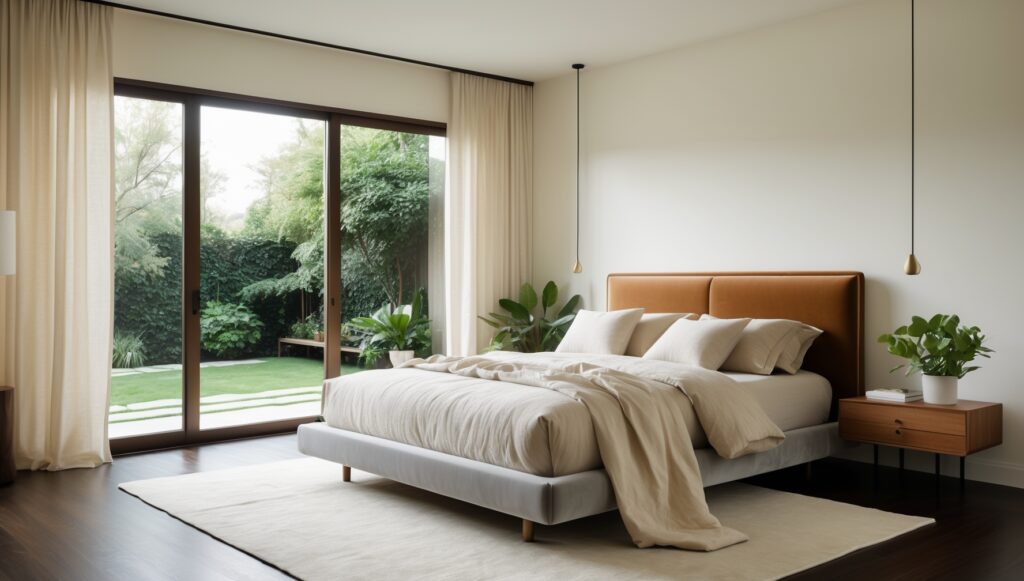15 Japandi Bedroom Design Ideas That Blend Serenity and Style
Creating a sanctuary within my home has always been my top priority. When I stumbled upon Japandi design, it felt like discovering a peaceful middle ground between minimalism and warmth. Japandi, a blend of Japanese elegance and Scandinavian simplicity, offers the perfect balance for a calming, functional, and aesthetically pleasing bedroom. In this guide, I’ll walk you through 15 Japandi bedroom design ideas that genuinely embody serenity and style.
What is Japandi Style?
Let me start with the basics so we’re on the same page.
Japandi: : A hybrid design style combining:
- Japanese design: Rooted in Zen philosophy, it emphasizes minimalism, natural materials, and craftsmanship.
- Scandinavian design: Focused on functionality, comfort (or “hygge”), and light, airy aesthetics.
Why Choose Japandi for Your Bedroom?
Choosing Japandi for my bedroom felt natural. Here’s why it might be right for you:
- Calming aesthetics: Neutral tones, decluttered spaces.
- Functionality meets comfort: Minimal but cozy.
- Eco-conscious materials: Wood, linen, organic textures.
- Long-lasting trend: Timeless rather than trendy.
1. Neutral Color Palettes


A Japandi bedroom starts with a neutral base. Think warm beiges, soft whites, and muted greys. I used a dusty taupe wall paint paired with natural wood tones in furniture. It instantly made my room feel lighter and calmer.
Materials to consider:
- Clay-based paints
- Limewash finishes
- Organic linens
2. Low-Profile Furniture


Opt for low-slung beds and furniture. In my space, I replaced a high-rise bed with a platform bed frame—closer to the floor, in line with traditional Japanese styles.
Benefits:
- Enhances openness
- Makes ceilings look taller
3. Decluttered Minimalism


Clear surfaces, functional decor. It’s not about having less for the sake of it, but making room for what truly matters.
How I decluttered:
- Limited nightstand items to lamp + book
- Donated unused furniture
- Added hidden storage under the bed
4. Mix of Textures


Combining rough and smooth, hard and soft textures adds depth. I paired a woven rug with a linen duvet, and it made all the difference.
Texture mix ideas:
- Bamboo lamps
- Linen bedding
- Wool throws
- Wooden headboards
5. Natural Light and Airflow


Japandi spaces thrive on natural elements. I took down heavy curtains and replaced them with linen sheers. It allowed soft light to pour in while keeping things private.
Pro tip: Leave at least one window bare for natural balance.
6. Earth-Tone Accents


Accent pieces should enhance the serenity. I used clay vases, sand-colored cushions, and forest-green art.
| Accent Type | Recommended Color | Suggested Material |
|---|---|---|
| Cushions | Moss green | Cotton or wool |
| Ceramics | Terracotta | Clay |
| Wall Art | Sand beige | Canvas or wood |
7. Functional Decor


Everything in a Japandi room should have a purpose. I chose a tray table as a nightstand and a bench at the end of my bed for both seating and storage.
Decor that serves a dual purpose:
- Mirrors with hidden hooks
- Storage ottomans
- Woven baskets
8. Soft Lighting Layers


Rather than a single overhead light, I created lighting zones: bedside lamps, floor lamps, and wall sconces.
My lighting choices:
- Rice paper lantern (Japanese)
- Wooden floor lamp (Scandinavian)
- Dimmable LED bulbs
9. Wooden Elements


Wood is central to Japandi. I added a light oak dresser and a reclaimed pine headboard.
| Furniture Piece | Type of Wood | Finish |
|---|---|---|
| Headboard | Pine | Matte wax |
| Dresser | Oak | Natural grain |
| Shelving | Bamboo | Oil-treated |
10. Wabi-Sabi Imperfections


Embrace flaws. I bought a hand-crafted ceramic lamp with a slightly uneven shape. It brought a quiet beauty that felt more personal.
Other wabi-sabi details:
- Cracked pottery
- Woven rugs with fringe
- Natural knots in wood
11. Low-Maintenance Greenery


Plants add life. I placed a ZZ plant and a rubber tree in minimalist pots.
Great Japandi plants:
- Snake plant
- Fiddle leaf fig
- Bamboo palm
12. Intentional Art Pieces


I replaced cluttered gallery walls with one large piece. Choose muted, abstract, or nature-themed art.
Art suggestions:
- Japanese ink paintings
- Nordic landscapes
- Wabi-sabi clay wall art
13. Clean Lines & Symmetry


I focused on symmetry in layout—matching lamps, centered bed. Clean lines in furniture made the space feel structured yet calm.
Tips:
- Avoid ornate carvings
- Stick to rectangular and square shapes
14. Cozy Scandinavian Layers


Even in minimalism, comfort matters. I layered soft blankets, flannel sheets, and a wool throw.
Cozy materials I used:
- Brushed cotton
- Wool blends
- Chunky knits
15. Personalized Ritual Corner


Japandi isn’t just aesthetics—it’s about intentional living. I created a small corner with a floor cushion, tea tray, and a calming diffuser.
Ideas for your ritual space:
- Zen garden tray
- Candle altar
- Floor reading nook
Q&A Section
Q. What is the difference between Japandi and Minimalism?
A. While both emphasize simplicity, Japandi adds warmth and texture through natural materials and cultural depth. Minimalism can feel sterile, while Japandi feels lived-in and comforting.
Q. Can I use color in a Japandi bedroom?
A. Absolutely! Stick to earthy tones like sage, clay, rust, or muted navy. These add dimension without overwhelming the calm.
Q. How do I make a small bedroom Japandi?
A. Use multi-purpose furniture, vertical storage, and keep a light color palette. Mirrors help reflect light and open up space.
Q. Is Japandi expensive to implement?
A. It doesn’t have to be. I thrifted many items or used DIY techniques like limewashing walls or staining old furniture.
My Final Thoughts
Designing my bedroom with Japandi principles has completely transformed how I sleep and recharge. It’s more than just a trend—it’s a lifestyle shift toward intention, simplicity, and peace. Whether you’re just swapping out textiles or doing a full makeover, these 15 ideas will bring you one step closer to a serene and stylish sanctuary.
So take a breath, light a candle, and start your Japandi journey. I promise it’s worth it.

